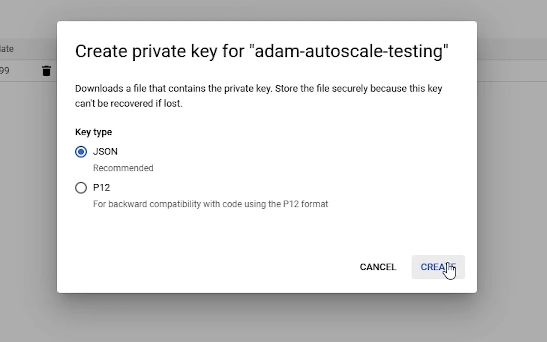Google Cloud (GCP) AutoScale
This guide will walk you through configuring autoscaling for Kasm Workspaces on Google Cloud (GCP). Autoscaling in Kasm Workspaces automatically provisions and destroys agents based on user demand, ensuring optimized resource utilization and cost efficiency.
Overview
Prerequisites
Access to Google Cloud (GCP): Ensure you have admin access to your Google Cloud (GCP) environment
Kasm Workspaces Installed: A basic setup of Kasm Workspaces must already exist
Understand Key Concepts:
Zones: Logical groupings of Kasm services for geographical or organizational segmentation
Pools: Logical groupings of Kasm Docker Agents and Server Pools for load balancing
Plan Your Configuration:
Understand your deployment zone requirements
Have access to your Google Cloud (GCP) details; target regions, networks, etc.
Create template images for your autoscale agents, if you require customisations baked into the images
Setup your GCP environment
Create service account: Go to “IAM” -> “Service Accounts” and create a new service account for use with Kasm AutoScaling. Also, make sure to give it the Compute Admin role.

Create Service Account in GCP
Create Key: Click on the created service account, and go to “Keys”. Click “Add Key” -> Select key type as JSON -> “Create”. This will generate a JSON file for you to download that contains all the authentication information required to configure AutoScaling on Kasm.

Create Key in GCP
Configure VM Provider Details on Kasm

GCP VM Provider
Name |
Description |
|---|---|
Name |
An identifying name for this provider configuration e.g. Google Cloud (GCP) Docker Agent Autoscale Provider |
GCP Credentials |
The JSON formatted credentials for the service account used to authenticate with GCP: Ref |
Max Instances |
The maximum number of GCP compute instances to provision regardless of the need for additional resources. |
Project ID |
The Google Cloud Project ID (e.g pensive-voice-547511) |
Region |
The region to provision the new compute instances. (e.g us-east4) |
Zone |
The zone the new compute instance will be provisioned in (e.g us-east4-b) |
Machine Type |
The Machine type for the GCP compute instances. (e.g e2-standard-2) |
Machine Image |
The Machine Image to use for the new compute instance. (e.g projects/ubuntu-os-cloud/global/images/ubuntu-2004-focal-v20211212) |
Boot Volume GB |
The size (in GB) of the boot volume to assign the compute instance. |
Disk Type |
The disk type for the new instance. (e.g pd-ssd, pd-standard, etc.) |
Customer Managed Encryption Key (CMEK) |
The optional path to the Customer Managaged Encryption Key (CMEK) (e.g projects/pensive-voice-547511/locations/global/keyRings/my-keyring/cryptoKeys/my-key |
Network |
The path of the Network to attach the new instance. (e.g projects/pensive-voice-547511/global/networks/default) |
Sub Network |
The path of the Sub Network to attach the new instance.(e.g projects/pensive-voice-547511/regions/us-east4/subnetworks/default) |
Public IP |
If checked, a public IP will be assigned to the new instances |
Network Tags (JSON) |
A JSON list of the Network Tags to assign the new instance. (e.g |
Custom Labels (JSON) |
A JSON dictionary of Custom Labels to assign the new instance (e.g |
Metadata (JSON) |
A JSON list of metadata objects to add to the instance.
(e.g |
Service Account (JSON) |
A JSON dictionary representing for a service account to attach to the instance.
(e.g |
Guest Accelerators (JSON) |
A JSON list representing the guest accelerators (e. GPUs) to attach to the instance.
(e.g |
GCP Config Override (JSON) |
A JSON dictionary that can be used to customize attributes of the VM request. The only attributes that cannot be overridden
are |
VM Installed OS Type |
The family of the OS installed on the VM (e.g. linux or windows). |
Startup Script Type |
The type of startup script to execute, this determines the key used when creating the GCP startup script metadata. Windows Startup Scripts Linux Startup Scripts |
Startup Script |
When instances are provisioned, this script is executed and is responsible for installing and configuring the Kasm Agent. Bash is supported on Linux instances and Powershell for Windows instance. Example scripts can be found on our Github repo |
Submit the Provider Config
Test Autoscaling
If you have configured non-zero Standby/Minimum Available Session values agents should start provisioning immediately, otherwise…
Provision a Workspace
Go to Workspaces > Registry
Make multiple workspaces available
Go to the Workspaces dashboard and launch sufficient workspace sessions to exceed your resource standby thresholds
Monitor the provisioning of new agents in the Docker Agents section
Verify new VM instances in Google Cloud (GCP)
Check Downscaling
Terminate sessions to reduce resource usage
Confirm that Kasm removes agents after the back-off period